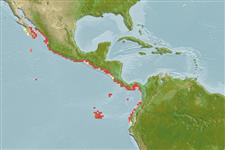Environment: milieu / climate zone / depth range / distribution range
Écologie
marin récifal. Tropical; 26°N - 3°S, 113°W - 76°W (Ref. 114953)
Eastern Central Pacfic: Baja California (Mexico) to Ecuador; including the Galapagos Is.
Length at first maturity / Taille / Poids / Âge
Maturity: Lm 110.0 range ? - ? cm
Max length : 260 cm TL mâle / non sexé; (Ref. 9254)
Inhabit rocky and coral reefs (Ref. 12951); on soft and sandy bottoms. Feeds mainly on mantis shrimps and fishes (Ref. 114953). Ovoviviparous (Ref. 50449). Litters of 1-5 pups; gestation period 10-11 months (Ref. 114953); Caught rarely by the gillnet fisheries operating in shelf waters. Utilized for its meat (Ref.58048).
Life cycle and mating behavior
Maturité | Reproduction | Frai | Œufs | Fécondité | Larves
Exhibit ovoviparity (aplacental viviparity), with embryos feeding initially on yolk, then receiving additional nourishment from the mother by indirect absorption of uterine fluid enriched with mucus, fat or protein through specialised structures (Ref. 50449). Distinct pairing with embrace (Ref. 205). Brood consists of 1-3 neonates and grow to about 40 cm DW in spring-summer (Ref. 38396).
Compagno, L.J.V., 1999. Checklist of living elasmobranchs. p. 471-498. In W.C. Hamlett (ed.) Sharks, skates, and rays: the biology of elasmobranch fishes. Johns Hopkins University Press, Maryland. (Ref. 35766)
Statut dans la liste rouge de l'IUCN (Ref. 130435)
Utilisations par l'homme
Pêcheries: intérêt commercial mineur
Plus d'informations
RéférencesAquacultureProfil d'aquacultureSouchesGénétiqueElectrophoresesHéritabilitéPathologiesTraitementNutrientsMass conversion
Outils
Articles particuliers
Télécharger en XML
Sources Internet
Estimates based on models
Preferred temperature (Ref.
123201): 23.1 - 28.5, mean 27 °C (based on 40 cells).
Phylogenetic diversity index (Ref.
82804): PD
50 = 0.5039 [Uniqueness, from 0.5 = low to 2.0 = high].
Bayesian length-weight: a=0.00646 (0.00265 - 0.01571), b=3.06 (2.86 - 3.26), in cm total length, based on LWR estimates for this (Sub)family-body shape (Ref.
93245).
Niveau trophique (Ref.
69278): 3.5 ±0.37 se; based on food items.
Résilience (Ref.
120179): Très faible, temps minimum de doublement de population supérieur à 14 ans (Fec=1-3).
Fishing Vulnerability (Ref.
59153): Very high vulnerability (90 of 100).
Nutrients (Ref.
124155): Calcium = 4.25 [0.50, 62.97] mg/100g; Iron = 0.352 [0.028, 3.714] mg/100g; Protein = 22.4 [20.0, 24.7] %; Omega3 = 0.0681 [, ] g/100g; Selenium = 41.8 [8.1, 218.8] μg/100g; VitaminA = 14.9 [1.2, 155.3] μg/100g; Zinc = 0.592 [0.036, 6.796] mg/100g (wet weight);
